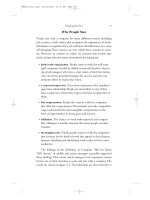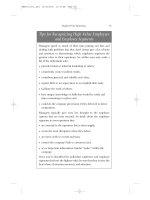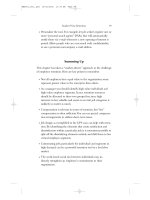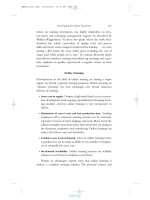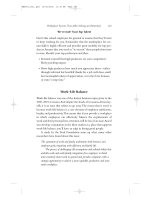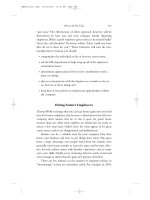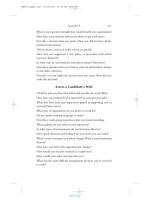Hiring and Keeping the Best People 16
Bạn đang xem bản rút gọn của tài liệu. Xem và tải ngay bản đầy đủ của tài liệu tại đây (119.87 KB, 8 trang )
return on training investments was highly dependent on rein-
forcement and unstinting management support. As described by
William Wiggenhorn: “In those few plants where the work force
absorbed the whole curriculum of quality tools and process
skills and where senior mangers reinforced the training . . . we were
getting a $33 return for every dollar spent, including the cost of
wages paid while people sat in class.” In contrast, Motorola plants
that failed to reinforce training with follow-up meetings and a gen-
uine emphasis on quality experienced a negative return on their
investment.
7
Online Training
Developments in the field of online training are having a major
impact on formal corporate training programs. Online learning, or
“distance learning,” has clear advantages over formal classroom
delivery of training:
•
Lower cost to supply.
Despite a high initial fixed cost in curricu-
lum development (and ongoing expenditures for keeping learn-
ing modules current), online training is very inexpensive to
deliver.
•
Elimination of travel costs and lost production time.
Sending
employees off to classroom training sessions can be extremely
expensive in terms of travel, lodging, and meals. Many resent the
added overnights away from home.And while they are sitting in
the classroom, employees aren’t producing. Online learning can
reduce all of these costs and drawbacks.
•
Scalable to any level of demand.
Once an online training course
is produced, it can be made available to any number of employ-
ees at essentially the same cost.
•
On-demand availability.
Online training sessions are available
whenever and wherever employees need them.
Despite its advantages, experts warn that online learning is
seldom a complete training solution. The personal contact and
Developing the Talent You Have 107
HBE001_ch5_.qxd 10/02/2002 11:35 AM Page 107
TEAMFLY
Team-Fly
®
interactions that occur in classroom settings or OJT are often essen-
tial to effective learning. Ernst & Young LLP, whose training pro-
gram was rated seventh in the U.S. by Training & Development mag-
azine in 2002, has a very powerful computer-enabled learning
portfolio. Still, the majority of its formal learning is completed
through traditional classroom experiences. So the best solution may
be to use online training in conjunction with other formal or
informal methods of skill training.
Career Development
Career development is an umbrella term that describes the many
training experiences, work assignments, and mentoring relationships
that move people ahead in their vocations. Any company that aims
to retain its most valuable people and to fill vacancies caused by
retirements, defections, and growth from within must dedicate
resources to career development. Ultimately, it can create a strong
“bench” of people who will one day lead the company as technical
professionals, managers, and senior executives. In effect, career devel-
opment is a form of “internal hiring.” Also, a reputation for career
development can make the company attractive to potential recruits
who are serious about building their careers.
Career Ladders
Human resource people often refer to career ladders when they talk
about career development.A career ladder is a logical series of stages
that move a talented and dedicated employee through progressively
more challenging and responsible positions. For example, in the
publishing business, a person with senior editorial aspirations might
be progressively moved through various positions in production or
marketing to editorial assistant to editor. Each step would broaden
his or her skills and understanding of the business.
108 Hiring and Keeping the Best People
HBE001_ch5_.qxd 10/02/2002 11:35 AM Page 108
Formal training is generally an important element on different
rungs of the career ladder. For example, an aspiring editor may need
to attend a three-day course on electronic publishing and another
on legal matters such as contracts and copyright rules. An R&D
bench scientist being groomed for a management position in prod-
uct development would benefit from course work in basic financial
analysis and marketing and from personal coaching in communica-
tion and team leadership.
Some firms systematically analyze a person’s current level of
skills and experience and match those against the skills and experi-
ences needed at the next step up the ladder. Gaps between what the
person has and what he or she needs are then addressed through a
plan that involves some combination of formal training, special
assignments, and regular mentoring by a respected superior, as
described in figure 5-1.
From a retention perspective, the career ladder approach is most
effective when it avoids “plateaus.”The employee should always feel
that he or she is learning and being challenged with a manageable
new set of responsibilities. There should be plenty of excitement
and no opportunity of feeling “stuck” on a career plateau. That
stuck feeling creates the potential for defection. If circumstances bar
a promising employee’s vertical advancement for the foreseeable
future, his or her manager should find some type of lateral assign-
ment that will engage the employee’s interest and provide learning
experiences.
Developing the Talent You Have 109
FIGURE 5-1
Filling Skill and Experience Gaps
• skill training
• enriching
assignments
• mentoring
Skills and
experience
needed for
new position
Employee’s
current skills
and experience
Measurable Gap
HBE001_ch5_.qxd 10/02/2002 11:35 AM Page 109
Now, ask yourself these questions about career ladders in your
unit:
•
What career ladders are available to your valued employees
right now?
•
Are they aware of those ladders and taking advantage of them?
•
Have you identified and made some provisions for the skills
and experiences that your charges will need to climb to the
next level?
•
Who, if anyone, is currently stuck on a plateau? What can be
done to get them off the plateau?
As a manager, it’s your responsibility to make sure that the peo-
ple you value are on progressively advancing career paths. Moving
ahead is good for them and increases the likelihood of their staying
with your company.Their progress is also good for you since it will
be easier for you to move up if you’ve developed a successor capable
of stepping into your shoes.
Mentors
The U.S. culture applauds the self-made person. But few successful
people are entirely self-made. Most successful people can point to a
relative or a boss—a mentor—who helped them make the most of
life’s lessons and guided their professional development. Former GE
CEO Jack Welch often pointed to his mother and the lessons he
learned from her early in life.
A study conducted by Harvard professor Linda Hill during the
late 1980s concluded that at least half of all executives had bosses
who mentored them during their careers.
8
That percentage may
have increased, since more and more job applicants are now inquir-
ing about mentoring opportunities within the organizations that are
recruiting them.
Hill points to three characteristics of effective mentors:
•
they set high standards;
110 Hiring and Keeping the Best People
HBE001_ch5_.qxd 10/02/2002 11:35 AM Page 110
•
they make themselves available to their charges; and
• they “orchestrate” developmental experiences.
Mentors who possess these characteristics play an important role
in facilitating career development. And by all accounts they make a
clear difference with respect to retention, perhaps because the fact of
mentoring tells the employee that “We care about you and think
that you are important.”
Common sense tells us that mentors provide a positive bond
between the employee and the firm.The strength of that bond is no
doubt determined by the effectiveness of the mentor and the inten-
sity of the mentoring relationship.And that suggests that you should
assign mentors with exceptional care. In addition to Hill’s three
characteristics, you should also seek mentor candidates who:
•
can empathize with an employee facing special challenges (for
example, a female executive mentor for a female employee in a
largely male organization);
•
have a nurturing attitude;
•
exemplify the best of the company’s culture; and
•
have rock-solid links to the organization.The last thing you
want to do is develop a bond between a promising employee
and a potential defector; nothing could sour the employee’s
outlook on the firm more decisively than to see his trusted
counselor take a walk.
Some companies make sure that every employee has an identifi-
able formal mentor; others reserve mentors for upwardly mobile
personnel. If your company or unit isn’t making effective use of
mentors in developing employee careers, consider developing a
mentoring program. Begin by identifying the people who would
benefit most from such a program; then, working with your own
leadership group and HR, determine who would be effective and
available as possible mentors.
Developing the Talent You Have 111
HBE001_ch5_.qxd 10/02/2002 11:35 AM Page 111
